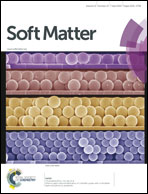Effect of poly(vinyl alcohol-co-vinyl acetate) copolymer blockiness on the dynamic interfacial tension and dilational viscoelasticity of polymer–anionic surfactant complex at the water–1-chlorobutane interface†
Abstract
Poly(vinyl alcohol-co-vinyl acetate) (PVA) copolymers obtained by partial hydrolysis of poly(vinyl acetate) (PVAc) are of practical importance for many applications, including emulsion and suspension polymerization processes. Their molecular characteristics have a major influence on the colloidal and interfacial properties. The most significant characteristics are represented by the average degree of hydrolysis  , average degree of polymerization
, average degree of polymerization  but also by the average acetate sequence length nVAc0 which designates the so-called blockiness. Colloidal aggregates were observed in the aqueous PVA solutions having a
but also by the average acetate sequence length nVAc0 which designates the so-called blockiness. Colloidal aggregates were observed in the aqueous PVA solutions having a  value of 73 mol%. The volume fraction of these aggregates at a given
value of 73 mol%. The volume fraction of these aggregates at a given  value is directly correlated to the blockiness. Three PVA samples with identical
value is directly correlated to the blockiness. Three PVA samples with identical  and
and  but different blockiness were examined. By pendant drop and oscillating pendant drop techniques it was shown that the PVA sample having the lowest blockiness and thus the lowest volume fraction of colloidal aggregates has lower interfacial tension and elastic modulus E′ values. On the contrary, the corresponding values are highest for PVA sample of higher blockiness. In the presence of sodium dodecyl sulfate (SDS), the colloidal aggregates are disaggregated by complex formation due to the hydrophobic–hydrophobic interactions. The PVA–SDS complex acts as a partial polyelectrolyte that induces the stretching of the chains and thus a reduction of the interface thickness. In this case, the interfacial tension and the elastic modulus both increase with increasing SDS concentration for all three PVA samples and the most significant effect was noticed for the most “blocky” copolymer sample.
but different blockiness were examined. By pendant drop and oscillating pendant drop techniques it was shown that the PVA sample having the lowest blockiness and thus the lowest volume fraction of colloidal aggregates has lower interfacial tension and elastic modulus E′ values. On the contrary, the corresponding values are highest for PVA sample of higher blockiness. In the presence of sodium dodecyl sulfate (SDS), the colloidal aggregates are disaggregated by complex formation due to the hydrophobic–hydrophobic interactions. The PVA–SDS complex acts as a partial polyelectrolyte that induces the stretching of the chains and thus a reduction of the interface thickness. In this case, the interfacial tension and the elastic modulus both increase with increasing SDS concentration for all three PVA samples and the most significant effect was noticed for the most “blocky” copolymer sample.


 Please wait while we load your content...
Please wait while we load your content...